Abstract
Metals differ from most synthetic organic chemicals in that their clinical manifestations are well known and methods for their measurement in the body are generally well established. Since metals are ubiquitous, special care should be taken to identify the source, whether dump site or not. Isotopic ratios may be used for lead. Time of exposure may be highly variable so estimates will be necessary of integrated "dose-commitment." Transmission to man will follow many pathways. The contamination of children's hands and clothing by dust may be an important route. Because effects are so different, the chemical species (e.g., organic versus inorganic forms) of each metal must be identified. Exposure assessment requires identification of suitable indicator media, usually blood in the case of lead, urine with cadmium and inorganic mercury, and blood or hair with regard to methylmercury. Human head hair may have considerable potential, as it may provide a recapitulation of past exposures. The first health complaints associated with most metals are usually nonspecific. The complex social, political, and legal issues strongly indicate the need for objective tests for health effects. Most important is the identification and measurement of the critical effect, i.e., an effect that alerts the public health authorities that further exposure should cease. For example, in the case of lead, the critical effect is hematologic; with cadmium it is the presence in urine of abnormally high concentration of small molecular weight protein; and with mercury no early objective test has yet been devised.
Full text
PDF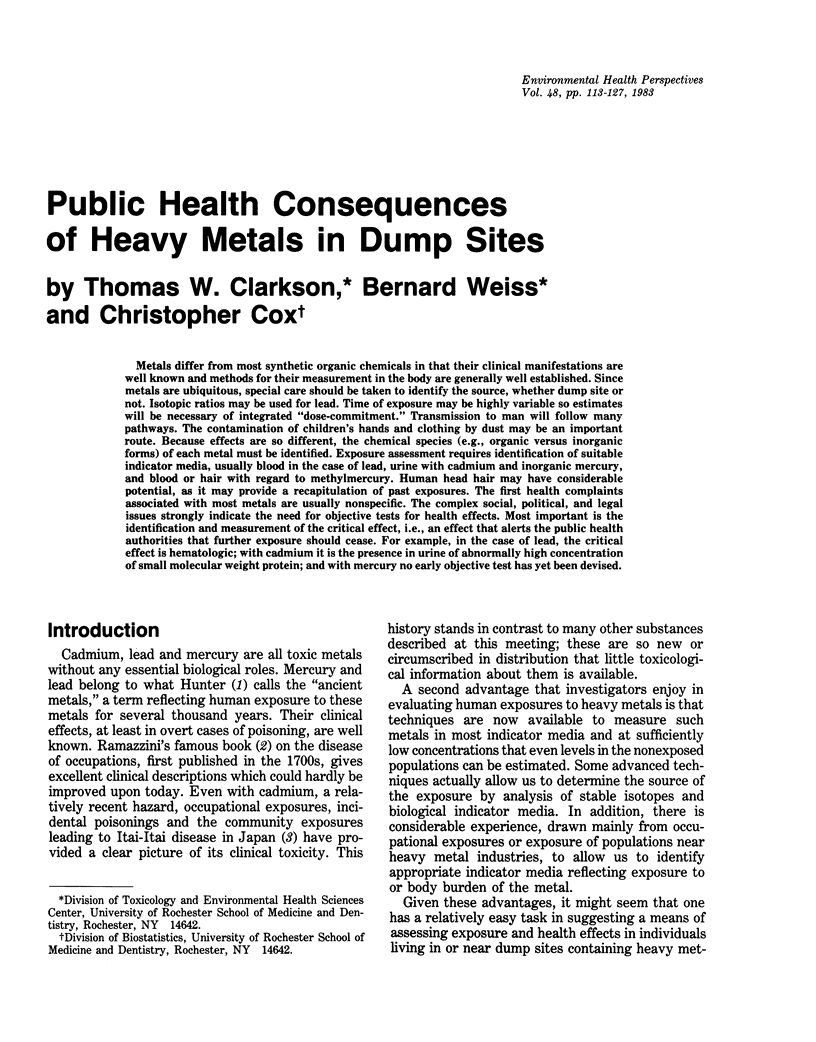
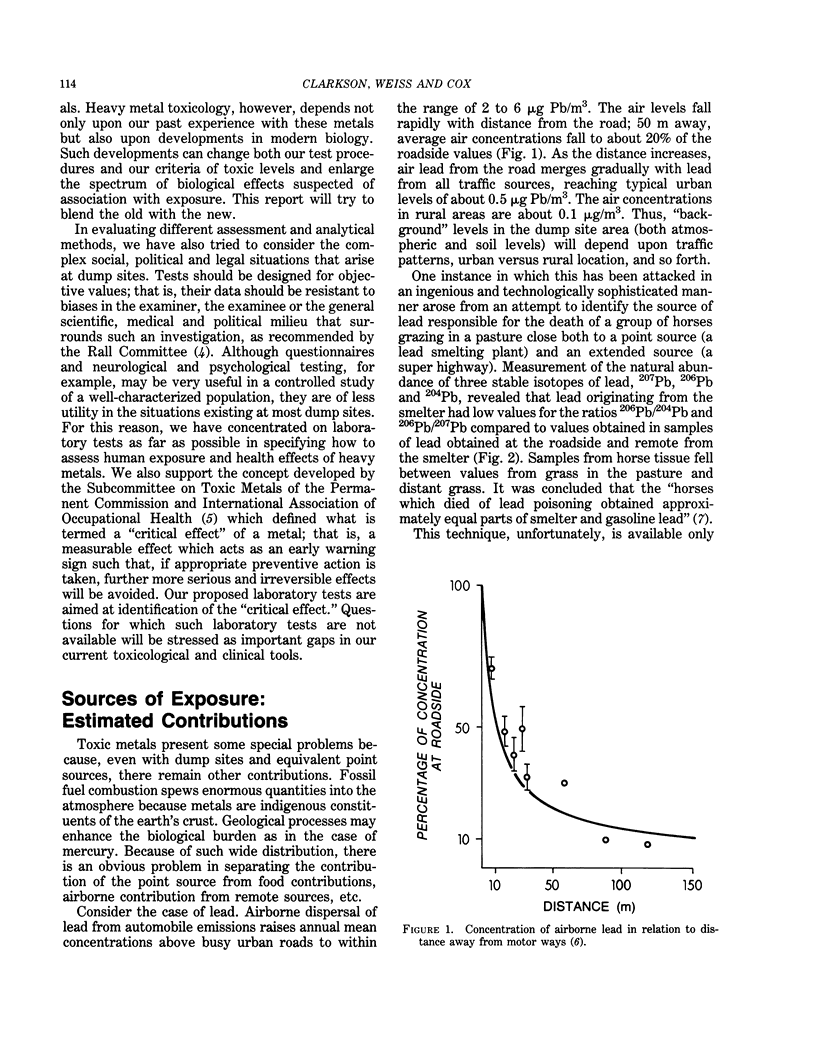
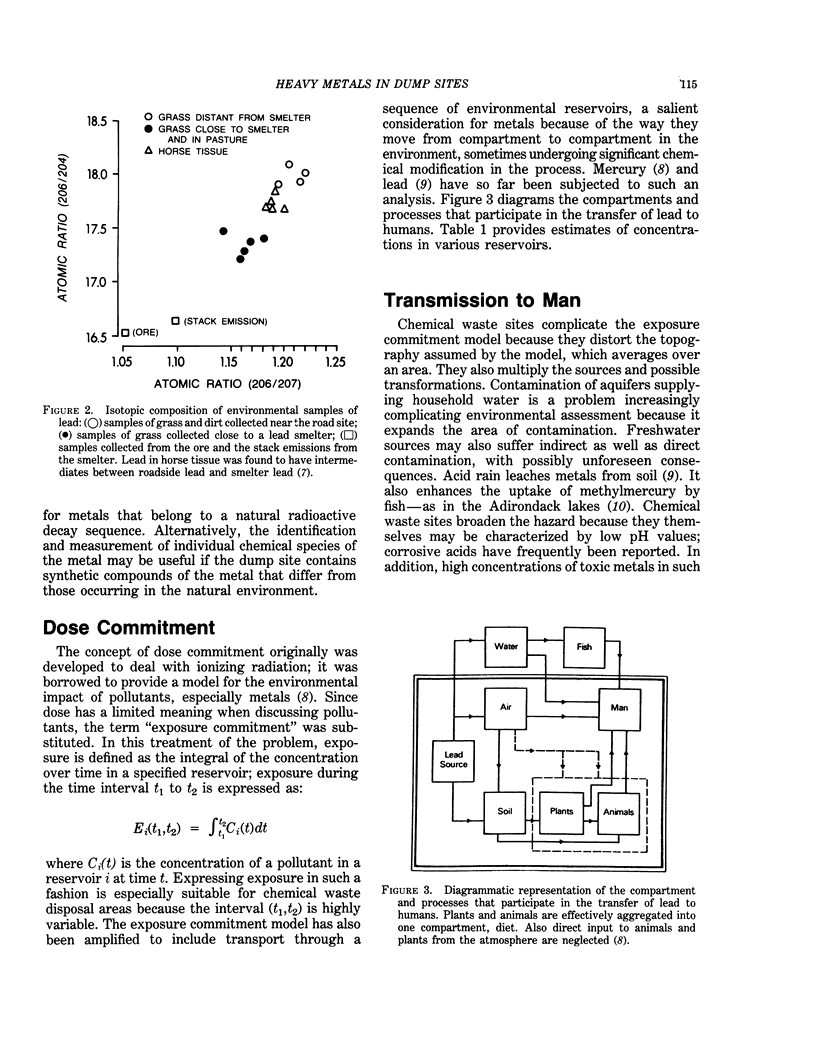


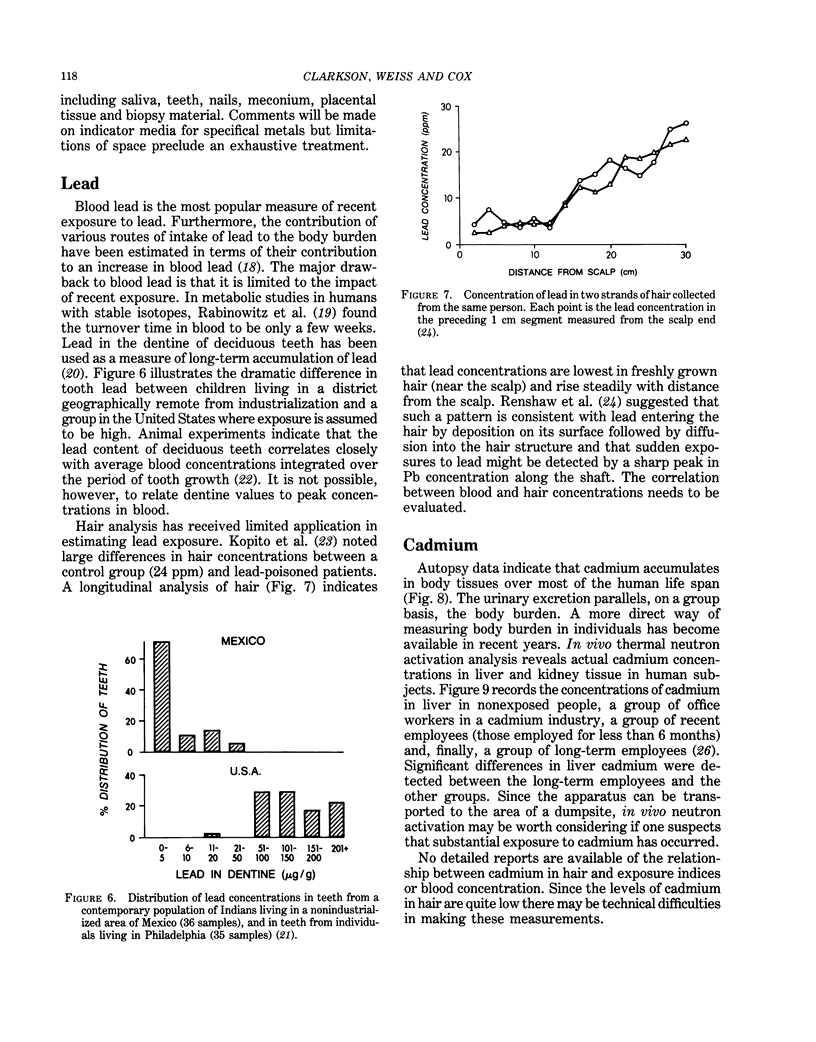
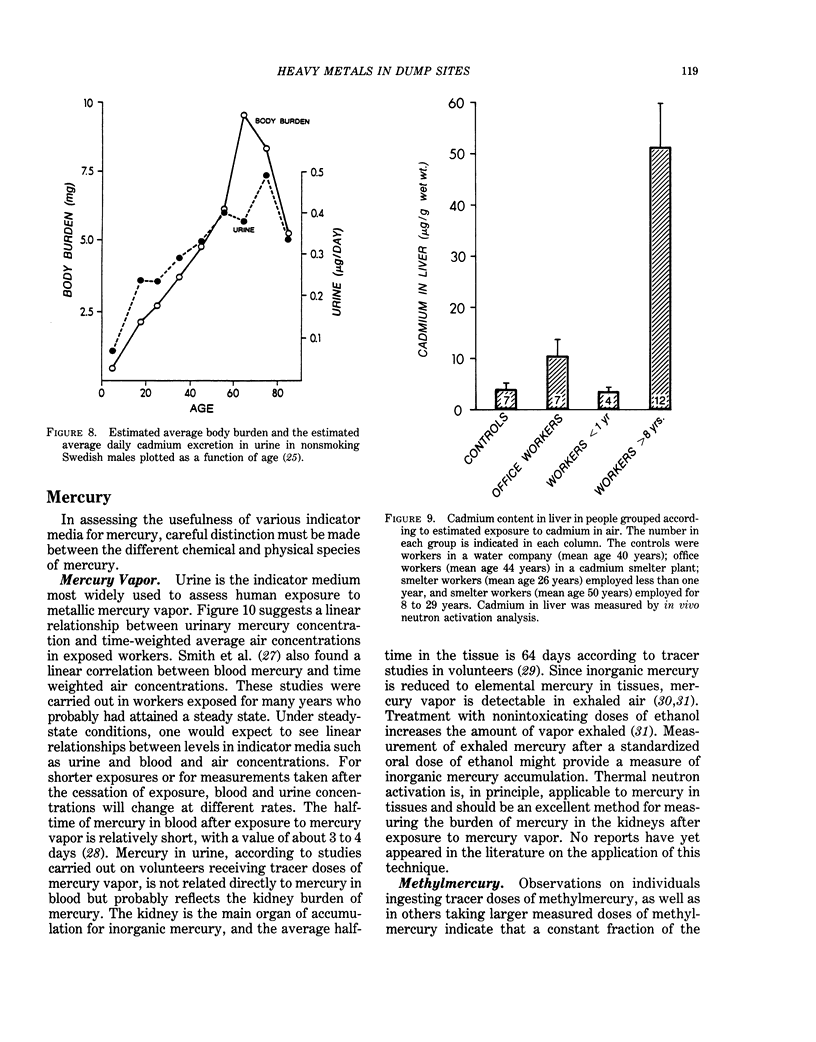

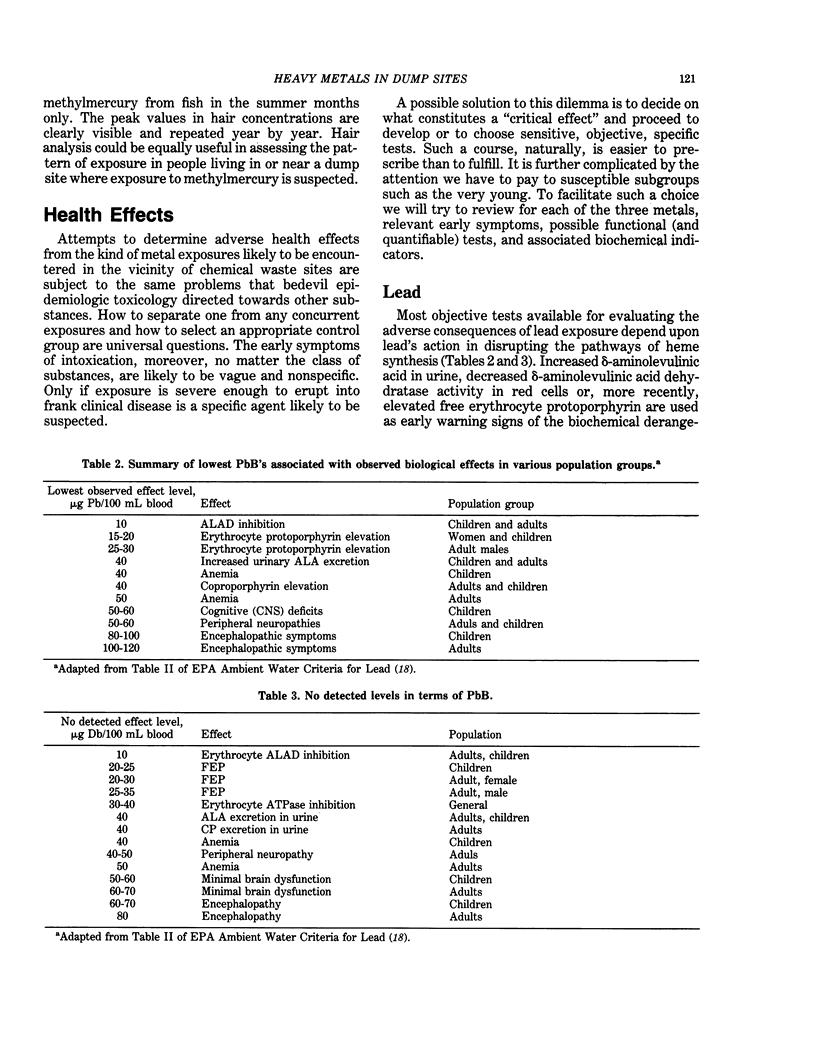
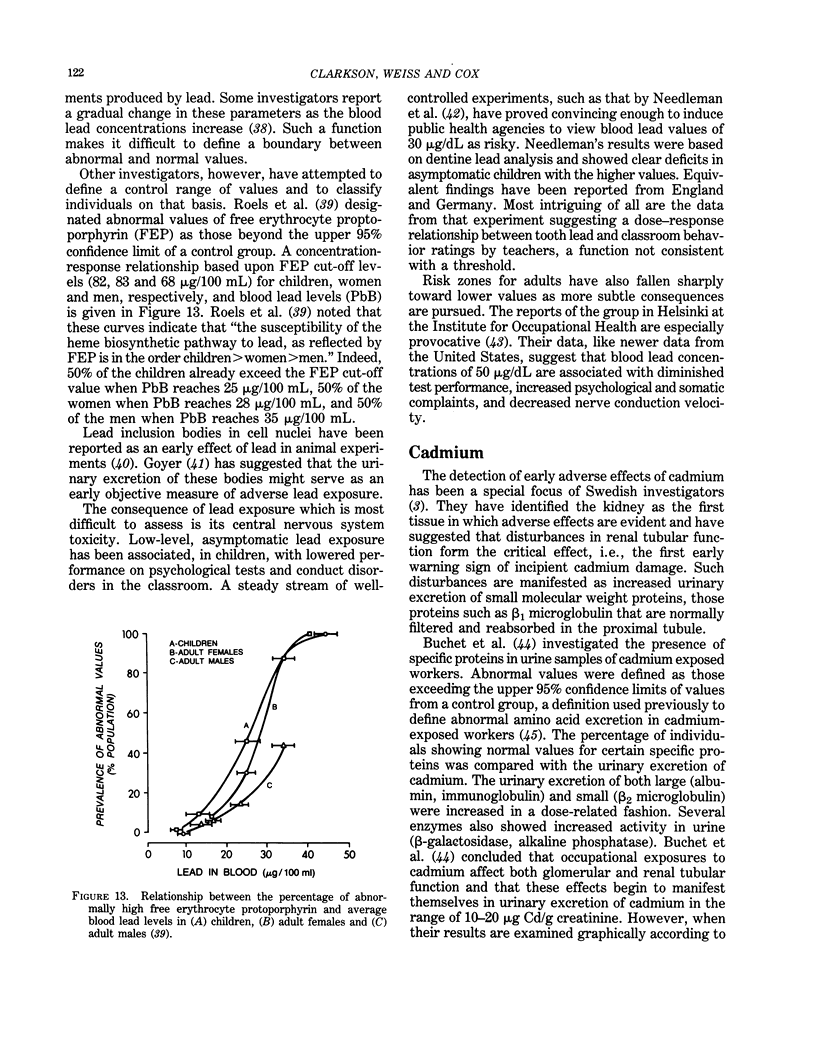

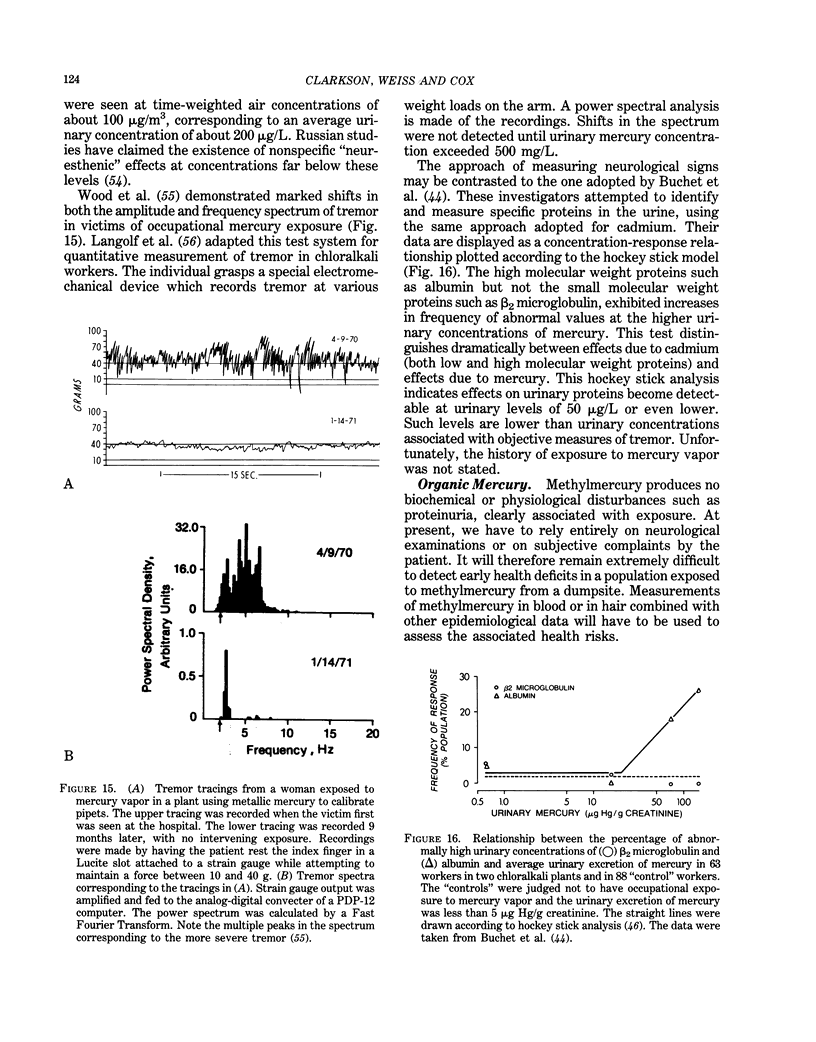
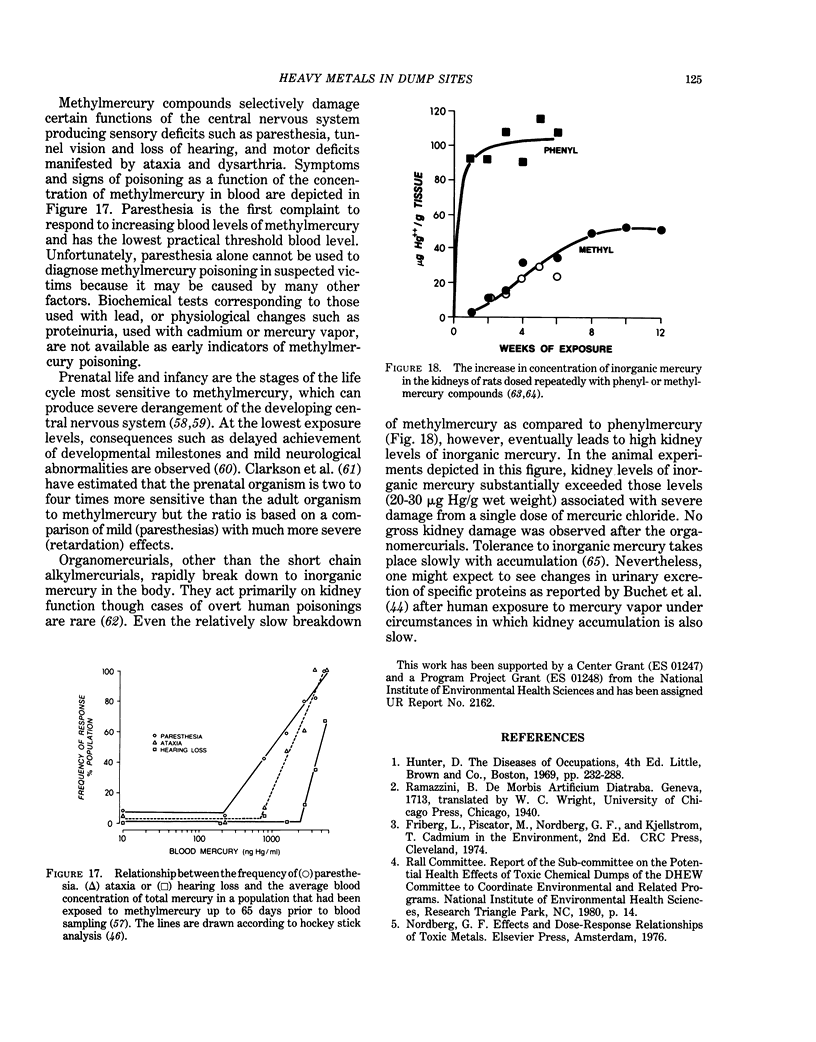

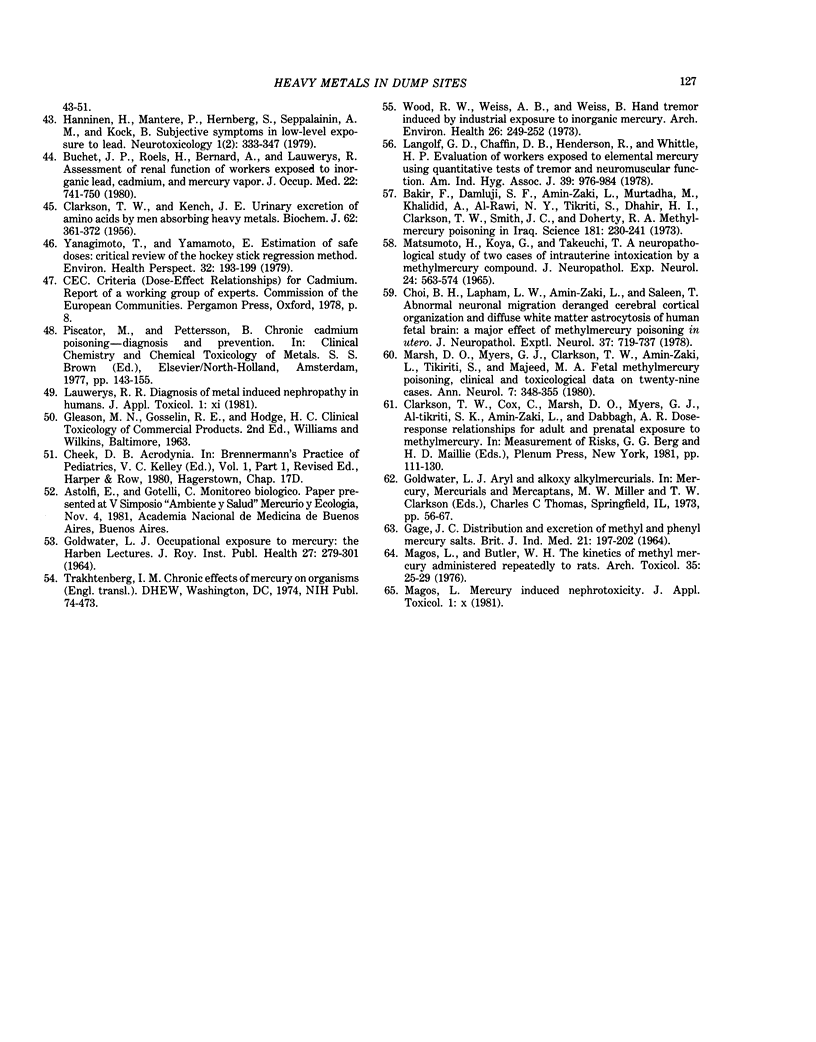
Selected References
These references are in PubMed. This may not be the complete list of references from this article.
- ALTSHULLER L. F., HALAK D. B., LANDING B. H., KEHOE R. A. Deciduous teeth as an index of body burden of lead. J Pediatr. 1962 Feb;60:224–229. doi: 10.1016/s0022-3476(62)80040-7. [DOI] [PubMed] [Google Scholar]
- Amin-Zaki L., Elhassani S., Majeed M. A., Clarkson T. W., Doherty R. A., Greenwood M. R., Giovanoli-Jakubczak T. Perinatal methylmercury poisoning in Iraq. Am J Dis Child. 1976 Oct;130(10):1070–1076. doi: 10.1001/archpedi.1976.02120110032004. [DOI] [PubMed] [Google Scholar]
- Bakir F., Damluji S. F., Amin-Zaki L., Murtadha M., Khalidi A., al-Rawi N. Y., Tikriti S., Dahahir H. I., Clarkson T. W., Smith J. C. Methylmercury poisoning in Iraq. Science. 1973 Jul 20;181(4096):230–241. doi: 10.1126/science.181.4096.230. [DOI] [PubMed] [Google Scholar]
- Buchet J. P., Roels H., Bernard A., Lauwerys R. Assessment of renal function of workers exposed to inorganic lead, calcium or mercury vapor. J Occup Med. 1980 Nov;22(11):741–750. [PubMed] [Google Scholar]
- CLARKSON T. W., KENCH J. E. Urinary excretion of amino acids by men absorbing heavy metals. Biochem J. 1956 Mar;62(3):361–372. doi: 10.1042/bj0620361. [DOI] [PMC free article] [PubMed] [Google Scholar]
- Cherian M. G., Hursh J. B., Clarkson T. W., Allen J. Radioactive mercury distribution in biological fluids and excretion in human subjects after inhalation of mercury vapor. Arch Environ Health. 1978 May-Jun;33(3):109–114. doi: 10.1080/00039896.1978.10667318. [DOI] [PubMed] [Google Scholar]
- Choi B. H., Lapham L. W., Amin-Zaki L., Saleem T. Abnormal neuronal migration, deranged cerebral cortical organization, and diffuse white matter astrocytosis of human fetal brain: a major effect of methylmercury poisoning in utero. J Neuropathol Exp Neurol. 1978 Nov-Dec;37(6):719–733. doi: 10.1097/00005072-197811000-00001. [DOI] [PubMed] [Google Scholar]
- Danziger S. J., Possick P. A. Metallic mercury exposure in scientific glassware manufacturing plants. J Occup Med. 1973 Jan;15(1):15–20. [PubMed] [Google Scholar]
- Dunn J. D., Clarkson T. W., Magos L. Ethanol reveals novel mercury detoxification step in tissues. Science. 1981 Sep 4;213(4512):1123–1125. doi: 10.1126/science.7268418. [DOI] [PubMed] [Google Scholar]
- Dunn J. D., Clarkson T. W., Magos L. Ethanol-increased exhalation of mercury in mice. Br J Ind Med. 1978 Aug;35(3):241–244. doi: 10.1136/oem.35.3.241. [DOI] [PMC free article] [PubMed] [Google Scholar]
- GAGE J. C. DISTRIBUTION AND EXCRETION OF METHYL AND PHENYL MERCURY SALTS. Br J Ind Med. 1964 Jul;21:197–202. doi: 10.1136/oem.21.3.197. [DOI] [PMC free article] [PubMed] [Google Scholar]
- Hursh J. B., Cherian M. G., Clarkson T. W., Vostal J. J., Mallie R. V. Clearance of mercury (HG-197, HG-203) vapor inhaled by human subjects. Arch Environ Health. 1976 Nov-Dec;31(6):302–309. doi: 10.1080/00039896.1976.10667240. [DOI] [PubMed] [Google Scholar]
- Jensen S., Jernelöv A. Biological methylation of mercury in aquatic organisms. Nature. 1969 Aug 16;223(5207):753–754. doi: 10.1038/223753a0. [DOI] [PubMed] [Google Scholar]
- Kershaw T. G., Clarkson T. W., Dhahir P. H. The relationship between blood levels and dose of methylmercury in man. Arch Environ Health. 1980 Jan-Feb;35(1):28–36. doi: 10.1080/00039896.1980.10667458. [DOI] [PubMed] [Google Scholar]
- Kopito L., Byers R. K., Shwachman H. Lead in hair of children with chronic lead poisoning. N Engl J Med. 1967 Apr 27;276(17):949–953. doi: 10.1056/NEJM196704272761703. [DOI] [PubMed] [Google Scholar]
- Langolf G. D., Chaffin D. B., Henderson R., Whittle H. P. Evaluation of workers exposed to elemental mercury using quantitative tests of tremor and neuromuscular functions. Am Ind Hyg Assoc J. 1978 Dec;39(12):976–984. doi: 10.1080/0002889778507898. [DOI] [PubMed] [Google Scholar]
- Marsh D. O., Myers G. J., Clarkson T. W., Amin-Zaki L., Tikriti S., Majeed M. A. Fetal methylmercury poisoning: clinical and toxicological data on 29 cases. Ann Neurol. 1980 Apr;7(4):348–353. doi: 10.1002/ana.410070412. [DOI] [PubMed] [Google Scholar]
- Matsumoto H., Koya G., Takeuchi T. Fetal Minamata disease. A neuropathological study of two cases of intrauterine intoxication by a methyl mercury compound. J Neuropathol Exp Neurol. 1965 Oct;24(4):563–574. [PubMed] [Google Scholar]
- Phelps R. W., Clarkson T. W., Kershaw T. G., Wheatley B. Interrelationships of blood and hair mercury concentrations in a North American population exposed to methylmercury. Arch Environ Health. 1980 May-Jun;35(3):161–168. doi: 10.1080/00039896.1980.10667486. [DOI] [PubMed] [Google Scholar]
- Rabinowitz M. B., Wetherill G. W., Kopple J. D. Lead metabolism in the normal human: stable isotope studies. Science. 1973 Nov 16;182(4113):725–727. doi: 10.1126/science.182.4113.725. [DOI] [PubMed] [Google Scholar]
- Renshaw G. D., Pounds C. A., Pearson E. F. Variation in lead concentration along single hairs as measured by non-flame atomic absorption spectrophotometry. Nature. 1972 Jul 21;238(5360):162–163. doi: 10.1038/238162a0. [DOI] [PubMed] [Google Scholar]
- Roels H. A., Buchet J. P., Bernard A., Hubermont G., Lauwerys R. R., Masson P. Investigations of factors influencing exposure and response to lead, mercury, and cadmium in man and in animals. Environ Health Perspect. 1978 Aug;25:91–96. doi: 10.1289/ehp.782591. [DOI] [PMC free article] [PubMed] [Google Scholar]
- Roels H. A., Buchet J. P., Lauwerys R. R., Bruaux P., Claeys-Thoreau F., Lafontaine A., Verduyn G. Exposure to lead by the oral and the pulmonary routes of children living in the vicinity of a primary lead smelter. Environ Res. 1980 Jun;22(1):81–94. doi: 10.1016/0013-9351(80)90121-8. [DOI] [PubMed] [Google Scholar]
- Shapiro I. M., Mitchell G., Davidson I., Katz S. H. The lead content of teeth. Evidence establishing new minimal levels of exposure in a living preindustrialized human population. Arch Environ Health. 1975 Oct;30(10):483–486. doi: 10.1080/00039896.1975.10666758. [DOI] [PubMed] [Google Scholar]
- Skerfving S. Methylmercury exposure, mercury levels in blood and hair, and health status in Swedes consuming contaminated fish. Toxicology. 1974 Mar;2(1):3–23. doi: 10.1016/0300-483x(74)90038-9. [DOI] [PubMed] [Google Scholar]
- Smith R. G., Vorwald A. J., Patil L. S., Mooney T. F., Jr Effects of exposure to mercury in the manufacture of chlorine. Am Ind Hyg Assoc J. 1970 Nov-Dec;31(6):687–700. doi: 10.1080/0002889708506315. [DOI] [PubMed] [Google Scholar]
- Wood J. M., Kennedy F. S., Rosen C. G. Synthesis of methyl-mercury compounds by extracts of a methanogenic bacterium. Nature. 1968 Oct 12;220(5163):173–174. doi: 10.1038/220173a0. [DOI] [PubMed] [Google Scholar]
- Wood R. W., Weiss A. B., Weiss B. Hand tremor induced by industrial exposure to inorganic mercury. Arch Environ Health. 1973 May;26(5):249–252. doi: 10.1080/00039896.1973.10666268. [DOI] [PubMed] [Google Scholar]
- Yanagimoto T., Yamamoto E. Estimation of safe doses: critical review of the hockey stick regression method. Environ Health Perspect. 1979 Oct;32:193–199. doi: 10.1289/ehp.7932193. [DOI] [PMC free article] [PubMed] [Google Scholar]


